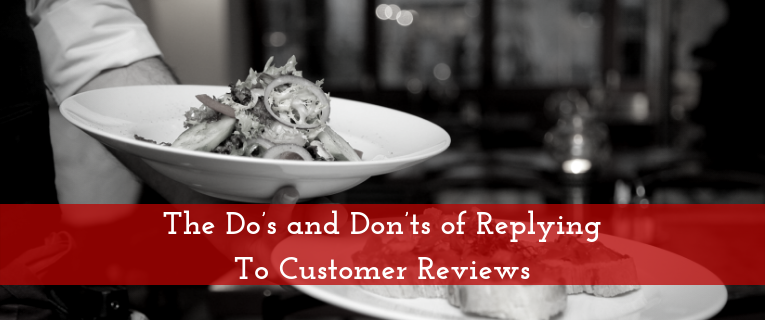Valentine’s Day is just around the corner, so I was looking into a place to take my girlfriend Shelley for a night out. I had been told about a restaurant from a few of my friends (shout out to word-of-mouth still being the most effective marketing out there) and decided to look it up and see what it was like. The website was very helpful, and all the food featured on the menu sounded amazing. The pictures showed a nice atmosphere and tasty-looking food. The final step of my research process was to look at the restaurants reviews, both the good and the bad.
Now, I realize that all places (especially restaurants) will have their negative reviews. These are often unusual occurrences, or situations where the customer is being unfair. However, what I found in the comments section for this restaurant was very interesting. It wasn’t the customer’s reviews that shocked me, but the owner’s responses to those reviews. This situation exemplifies lessons for anyone who has any customer service function (which is everyone, really). Here are three lessons you can learn from this owner and also some ways to better handle the situation.
Don’t Air Out Your Dirty Laundry Online
Being accessible to your customers is important. That’s why it’s smart to interact with their reviews online. Customers want to feel that their opinions are valued and nothing accomplishes that more than attention from the organization’s leadership. In this instance, it was a restaurant owner replying to reviews of his restaurant.
The problem here is that you don’t want to get in a confrontation online over a negative review. The owner of the restaurant berated several customers who left negative reviews, and would openly talk about the customer’s situation in the reviews. This comes across as aggressive and very unprofessional. The situation worsened when a negative reviewer replied to the owner’s comment with an update explaining the whole situation. Needless to say, it looked even worse than just the original review.
While you may feel that the customer is wrong, you need to stick with the age old adage that “the customer is always right.” An appropriate response would be to apologize for their complaint and ask them to contact you privately so you can hear their whole story and try to come to an understanding. You can even offer to help make up for their bad experience. This shows the customer that you care about their opinion and that you are trying to make the situation better. You can turn a disgruntled customer into a lifelong fan of your product just by respectfully engaging with your customers. A free meal (or whatever your product is) isn’t too much to pay for a lifetime of patronage. If you don’t want to do any of the above, just not saying anything would be better than lambasting customers online.
Don’t Make Mountains of Excuses
It may sound harsh but a customer does not want to hear about all the problems that you are experiencing and why it made their experience less than desirable. They are a paying customer who did not receive a final product that met their expectations. Don’t blame your short-comings on being short-staffed, don’t blame it on a bad night, just take responsibility and apologize. The quicker you apologize, the quicker you can begin to set things right and repair your reputation.
The owner did not adhere to this ideology and would blame bad service and bad food on anything and everything. I do, however, have to give the owner credit for one of his excuses. He recognized a complaint about there being too many fraternity members in the restaurant and how that was not the atmosphere the customer expected, and then apologized for the experience. Then, he explained that the night in question was a discount night for local college students. He shouldered the blame and then explained that this wasn’t an everyday occurrence but a planned, weekly event. If there is something about your product that someone doesn’t understand, explain it to them, but don’t blame issues in product quality on extenuating circumstances. Apologize and look for a solution.
Do Not Haggle Over Ratings
At the time of one person’s review, the restaurant’s website had been hacked and the page had a problem. A customer noticed this and included it as a negative in her review, which was a 3-star review. The owner replied and said that he was working on the situation but said that the reviewer should reconsider their rating because the website had nothing to do with the restaurant. This was the most surprising and cringy thing I saw in that review section.
NEVER haggle a reviewer over their review. The reviewer has stated their opinion. Haggling over that person’s rating shows them that you do not care about their opinion; you just want to improve your standing. One of the stranger points about this case is that the restaurant had a 4.6 on Google reviews and similar ratings on both Yelp and TripAdvisor. The restaurant already has a pretty solid reputation and did not need an extra star or two.
Going back to the first point, you can contact the reviewer and create a dialogue to help remedy the situation. The owner must have done this at some point because one reviewer updated his 1-star review to a 4-star review and said that, because the owner had tried to make things right and “obviously cares about the customer experience,” he wanted to revise his original review. Doing things the right way, and not causing an online scene by haggling over ratings, is the way to impress disappointed customers and create long-lasting relationships with them.
The lessons learned from this owner aren’t hard to implement. They just take patience and a cool head. Reach out and try to respectfully communicate with the customer who had a problem, take responsibility, and work to find a solution that shows you care about the customer’s experience. Doing these things will help bolster the reputation of your product and will keep them coming back for more.





